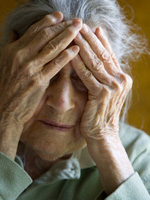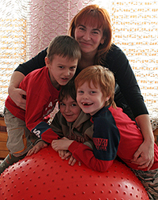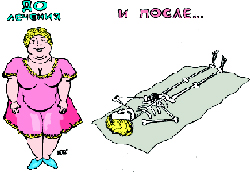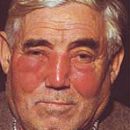Lyubility does not always come in itself - very often it comes after the suffering diseases. And the leader of such diseases is a stroke. This article will talk about the features of vascular dementia.
Content
Symptoms and current
Mental manifestations in the vascular pathology of the brain are diverse in both the nature and depth of disorders: from neurotic symptoms and sharpening character traits to psychotic episodes and pronounced dementia (called vascular dementia).
At the initial stage of the disease, patients complain of headaches, dizziness, noise in the head, sleep disorders, fast fatigue, irritability, intolerance of strong stimuli, forgetfulness. Mood can be reduced with a tint of anxiety or tearfulness.
Character changes: how the other features are erasing and other or hypertrophy. In the involutionary age (up to 60 years), such personal features are enhanced or appear as anxiety, indecisiveness, imperisibility, syradiability. For senile age, selfishness, miserness, worn, stabbing, indifference to others.
When progressing the vascular process, signs of identity and intelligence, T.E. dementia. It is manifested by rigidity (negotiation to changes) and the circumstance of thinking, the weakening of memory for current events and the difficulty of mastering the new material, the narrowing of the perception and decrease in its clarity, as well as a change in the level of judgment, conclusions and productivity of intellectual activity.
Treatment of vascular dementia
First of all, it is necessary to test the vascular disease. Along with this, drugs regulating metabolic processes (nootropyl, encephybol, pyriditol, gammalon) are widely used and contributing to the improvement of memory, as well as drugs that increase the blood supply level of the brain (Cavinton, Starbonon, complemin, Trental). Selection of drugs is carried out only by a doctor, taking into account the nature of the vascular process. Psychotropic therapy is prescribed by a psychiatrist depending on the mental state of the patient with dementia.

Unattended awareness of the disease and the ability to critically evaluate their condition helps such patients to adapt to life and to determine the symptoms of the disease, in particular, memory disorders. «Core» Personality remains preserved, t.E. Skills and style of behavior, personal installations, the nature of relationships and reactions are preserved.
The pronounced memory disturbances, including difficulties in reproducing the nearest events (events of youth and childhood, usually remember well, sometimes even improve their reproduction), contribute to a decrease in mental activity, the predominance of depressed tearful mood, the emergence of feeling of helplessness and insecurity.
With frequent violations of the brain circulation, memory disorder becomes more rude, and weakly - deeper. In addition, under cerebral atherosclerosis and hypertension, accompanied by complications in the form of strokes, the formation of post-softening softening and cyst, there are sharp mental manifestations of illness, more often at night.
Such nights «Consciousness confusion states» briefly and can often repeat. In these psychosis, different mental arrangements or twilight permanent of consciousness may prevail. And one syndrome can be replaced by another. Most often acknowledging consciousness according to the type of delicacy (disorder of consciousness), the remaining forms are quite rare.









